Editor’s Note: The following review is of pre-production hardware. StorageReview has updated the OCZ RevoDrive 3 X2 review with revised benchmarks with the final build hardware and firmware here.
When it comes to desktop-based high-performance storage, to get to the bleeding edge there are certain limits you have to work around. A single SATA SSD, no matter how fast it is, will be held back by the 6.0Gb/s bandwidth. To get around this, many opt for the PCIe interface, either by using a RAID card with multiple drives grouped together or a PCIe integral storage solution. Today we look at the latter option with the latest in OCZ’s RevoDrive family of enthusiast SSDs, the RevoDrive 3 X2. Incorporating four SandForce SF-2281 processors and 480GB of tier one NAND flash; the OCZ RevoDrive 3 X2 drives read speed up to 1500MB/s and writes of 1250MB/s and 4K random write IOPS of 200,000.
PCI-Express based SSDs are an elegant solution to what some users face when they look to increase system performance. While you could easily string together four SSDs through a RAID card, the end result would be much more complicated. You would need to have four drive holders, four power adapters, additional data cables in the system, and still have the space used up by the RAID card if you don’t have enough available SATA 6.0Gb/s ports for 4x RAID0. The PCIe SSD solution takes up one expansion slot and thats it… no power cables, no extra bulk, just one card and you’re done.
At the heart of the OCZ RevoDrive 3 X2 is a specialized VCA 2.0 (Virtualized Controller Architecture) controller which offers flexibility across multiple platforms and devices. The VCA ties together four SandForce SF-2281 controllers, which considering the performance from just one, gives this card a ton of potential.
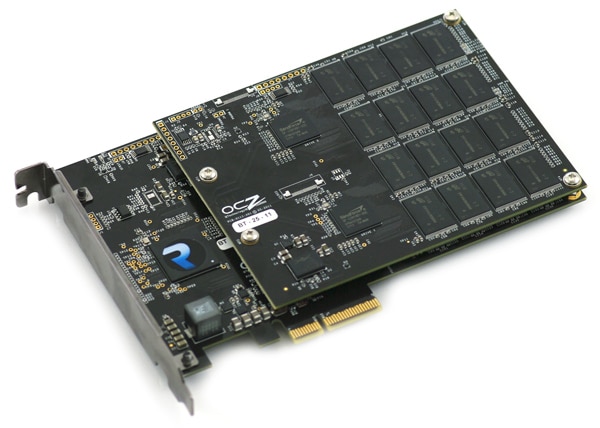
OCZ RevoDrive 3 X2 (480GB) Specifications:
- PCIe 4x interface
- Four SandForce SF-2281 Controllers
- Custom OCZ VCA 2.0 RAID Controller
- Max Sequential Speeds: up to 1500MB/s Read and up to 1250MB/s Write
- Random Write 4KB (Aligned): 200,000 IOPS
- 25nm Intel/Micron asynchronous MLC NAND
- 3-Year Warranty
- Revo 3 X2 Retail Price: 240GB $699.99, 480GB $1699.99, 960GB $3199.99 (Revo3 120G $399, 240G MSRP $599, 480G $1499)
Aesthetics
The OCZ RevoDrive 3 X2 is a full-height PCI-Express card with an additional daughter board attached doubling the capacity and performance by adding two additional SandForce controllers. Our beta model is rather basic, not even including a controller heatsink or OCZ-branding logo over the controller (although stickers were provided for photos and a heatsink will be added to the retail model).
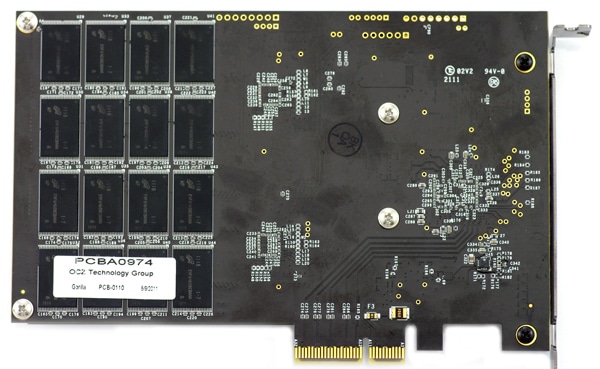
OCZ didn’t leave much wasted space on this card, with the bulk of it taken up by the 25nm Micron NAND flash. In terms of design touches, the card has a little OCZ-branding with a semi-gloss black finish. Not much is included in the way of configuration options or debugging modes beyond an assortment of LEDs which light up throughout the power-up process and show drive activity status.

The main interface is a 4x PCIe connector, providing up to 1000MB/s of bandwidth on an older PCIe 1.0 slot or 2000MB/s through a 2.0 slot. The drive also pulls all its power from this connector as well, so no additional hookups are required.
Disassembly
Not much is required in the way of tearing down the OCZ RevoDrive 3, as it is already completely exposed by design. One component that can be removed is the daughter board, mounted on small risers using four Phillips head screws. With these removed you simply lift the card straight up and disconnect it from the port toward the front of the board.
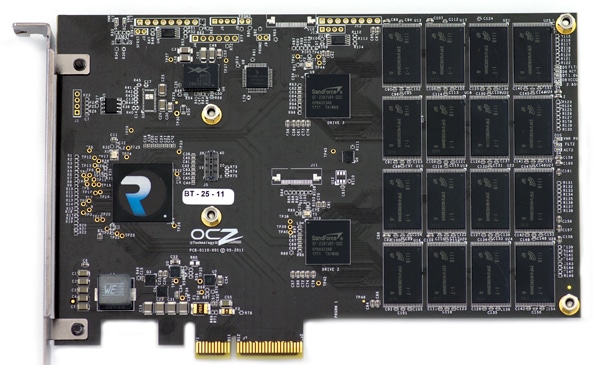
In some ways it is almost easier to think of the Revo3 X2 in terms of how many Agility 3s it has onboard, since they both share the same asynchronous NAND. With a total of 64 flash chips, 16 are allocated for each controller, filling up all available channels for maximum speed. That works out to 128GB of NAND per device all routed through the OCZ VCA 2.0 controller.
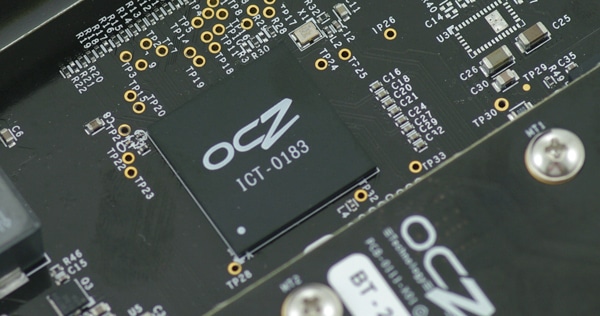
The 480GB version of the OCZ RevoDrive 3 X2 includes 64 8GB 29F64G08CBAAA 25nm Micron NAND pieces and four SandForce SF-2281VB1-SDC processors. OCZ uses of asynchronous NAND in this model, leaving faster synchronous NAND for their enterprise-class Z-Drive.
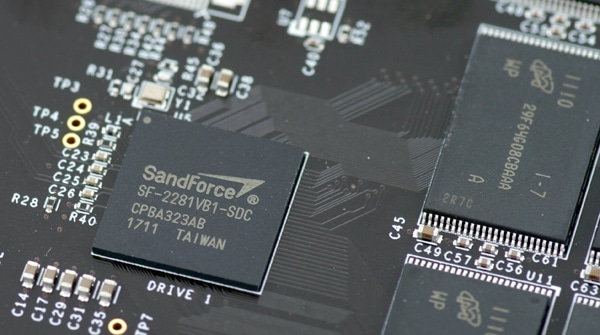
Synthetic-Benchmarks
We tested the beta-version of the OCZ RevoDrive 3 X2 in our newer test rig, although for the closest comparison, we included results from the LSI WarpDrive we reviewed earlier this year which was tested in our older platform. While not the best possible scenario, it still gives a very good indication of how the drive stacks up against similar models (even if the LSI is much more expensive). After we get our hands on the retail production version of the RevoDrive 3 X2, we will include performance stats from both our new test rig and old platform to cross-check any variability in scores. One question that will pop up though is why we compare a enthusiast card that costs $1,700 against an enterprise one that goes for over $9,000? Well as you will see below for single-user scenarios the RevoDrive 3 X2 has no trouble keeping up with the big boys and the form factors make comparisons inevitable.
To get an idea of the straight line performance of the Revo3 X2 we start off with a 2MB sequential transfer test using IOMeter. OCZ rates the top speed of the Revo3 at over 1500MB/s which isn’t too far off from the speed of four Agility 3 SSDs combined.
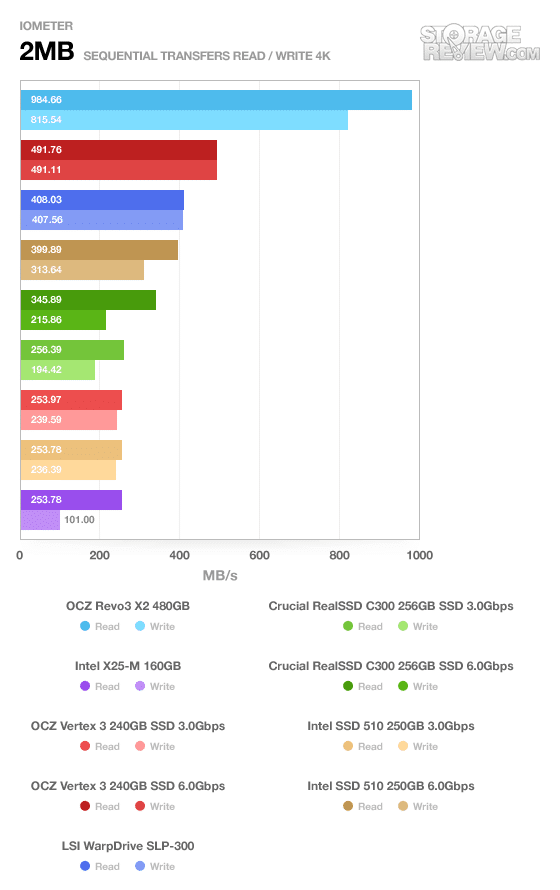
With one manager and one worker inside IOMeter, we recorded a peak read speed of 984MB/s and a write speed of 815MB/s using repeating data. This is nearly double the speed of the LSI WarpDrive under the same conditions.
Our next test we keep the transfer size the same, although now we switch to a random transfer test. Since SSDs don’t see a huge impact between large sequential and random transfers, we don’t expect to see a huge difference in speeds from the test above.
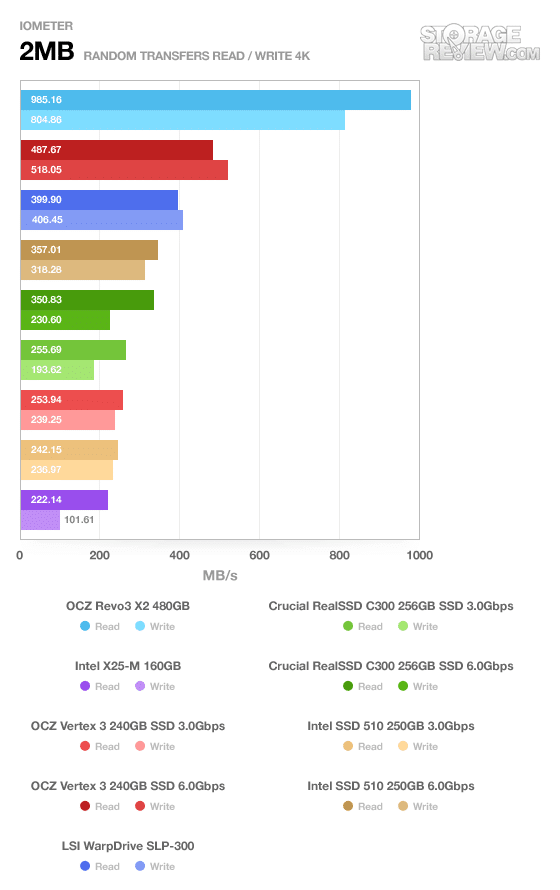
In ths 2MB random transfer test we measured 985MB/s read and 804MB/s write, still more than double the speed of the WarpDrive.
In our first 4K random transfer test we stick with a queue depth of one, to measure how much speed each drive offers off the line. In most single-user environments, this is one area that will be felt.
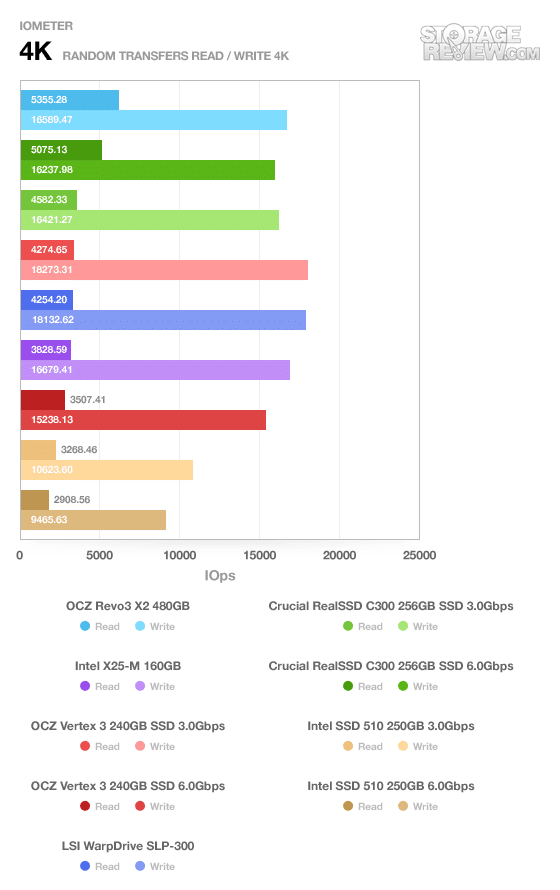
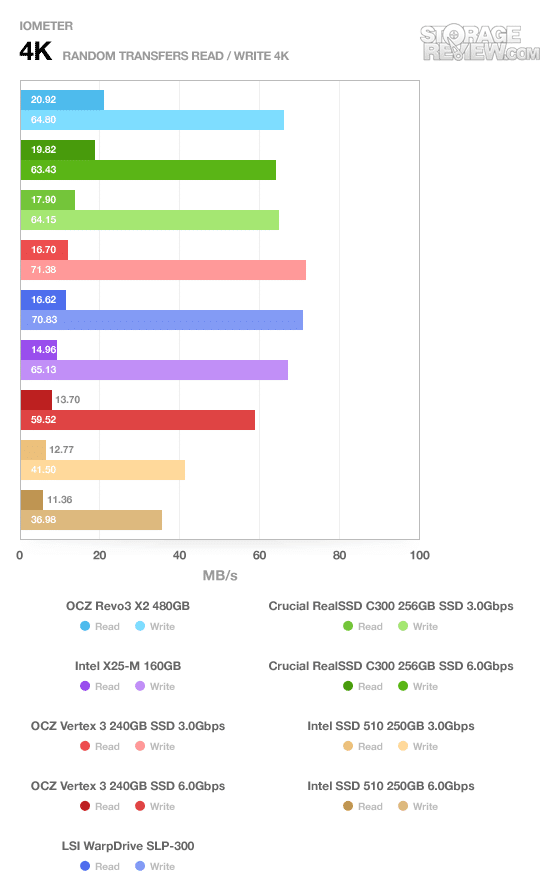
The OCZ Revo3 led the pack with the highest 4K random read speed measuring 20.92MB/s, although slipped in write speed measuring just 64.80MB/s.
Our next section expands on the 4K random transfer test, this time measuring the speed as the queue depth or load on the drive increases.
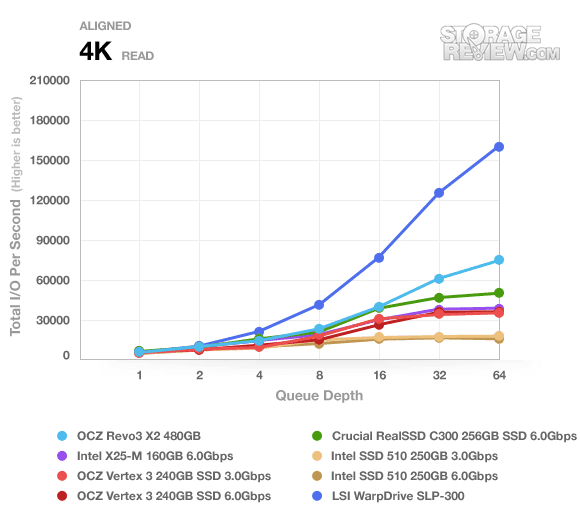
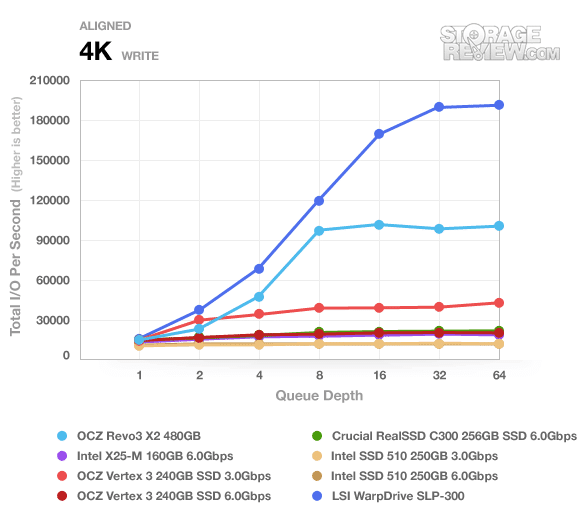
This test was slightly slanted from the start, with the LSI WarpDrive having a huge advantage in greater PCI-Express slot bandwidth, faster SLC NAND, and six individual SF-1200 processors tied into a hardware RAID controller. Even at a fairly large disadvantage, the Revo3 X2 still did pretty well compared to the rest of the pack. At a queue depth of 64, read speeds topped out at roughly 77k IOps, while write speeds climbed to around 103k IOps.
The OCZ RevoDrive 3 X2 came in fourth in our 4K write latency, with an average response time measuring 0.060ms with a peak latency of 41ms.
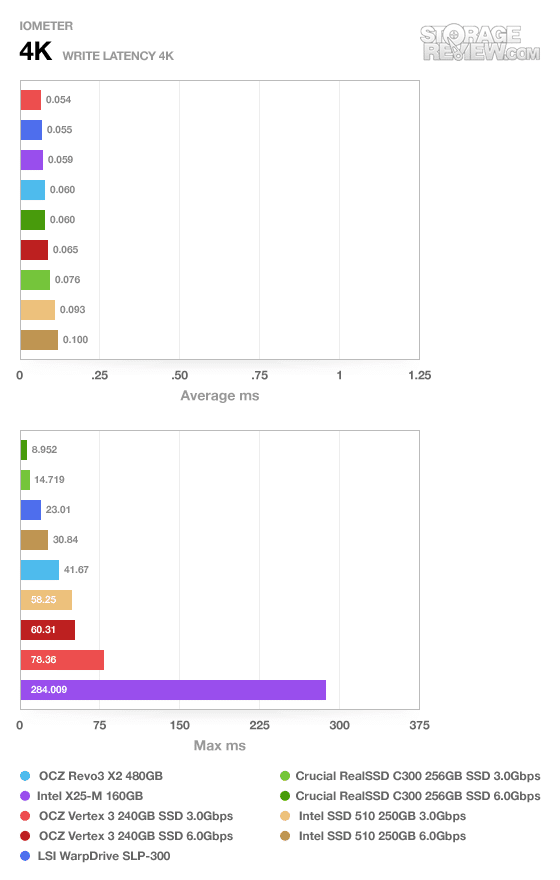
Using the default CrystalDiskMark 3.0 testing suite with random data, we see that the read speeds decreased from almost 1,000MB/s to just under 700MB/s. Write speeds saw a similar hit, dropping from 815MB/s to 513MB/s. Compared to the single 240GB Agility 3 this worked out to roughly twice the speed.
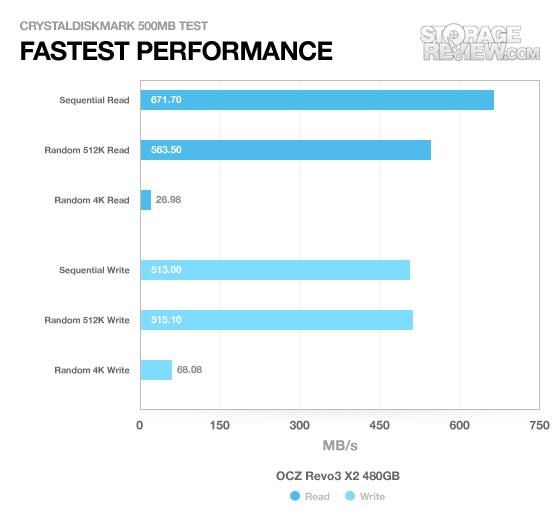
Our final section of synthetic benchmarks cover enterprise scenarios with an exponentially increasing queue depth load up to 128. These tests show off how well a drive handles NCQ operations and how it manages heavy multi-tasking loads.
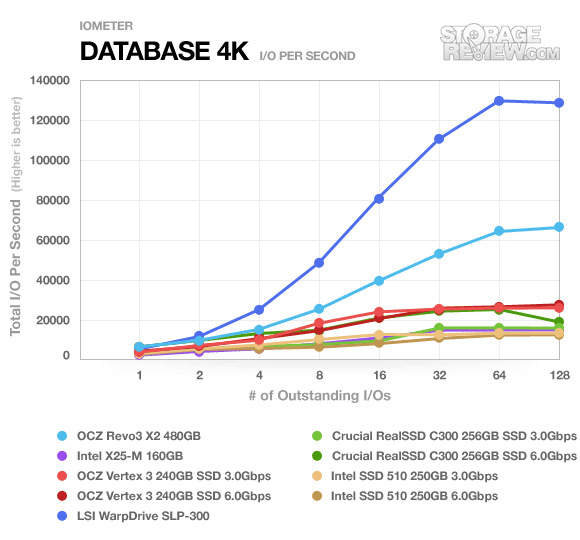
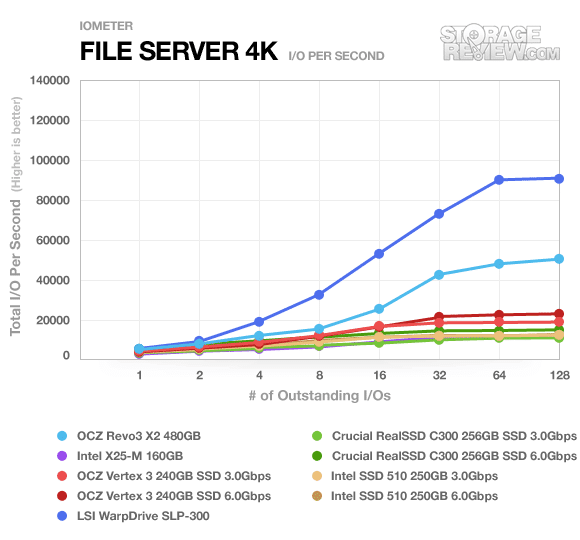
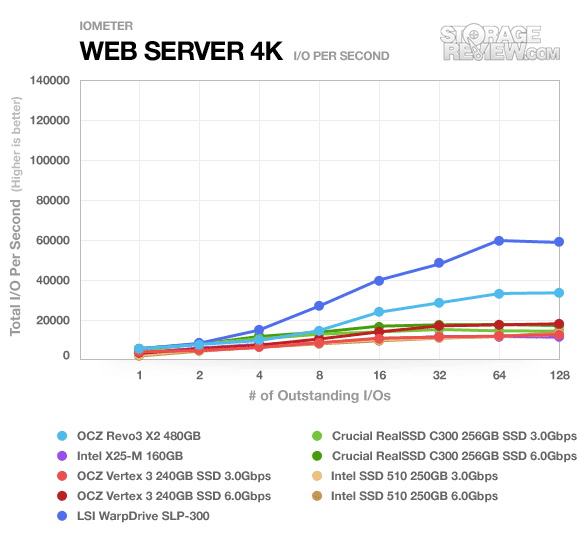
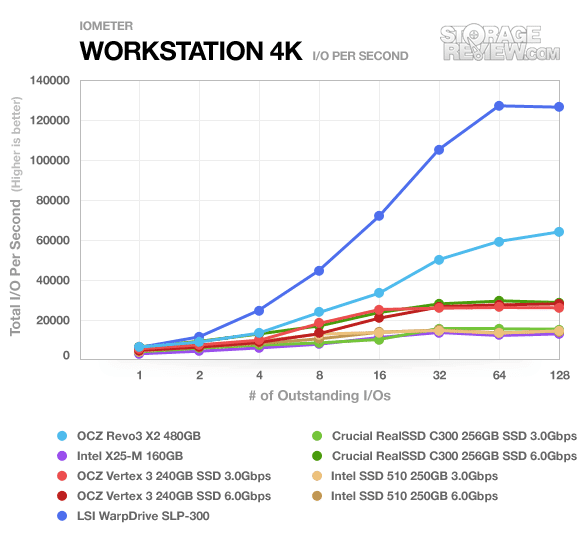
Real-World Benchmarks
If you are new to StorageReview, one thing we try to focus on is how any given drive might perform under real-world conditions. For the average user, trying to translate random 4K write speeds into an everyday situation is pretty difficult. It helps when comparing drives in every setting possible, but it doesn’t exactly work out into faster everyday usage or better game loading times. For this reason we turned to our StorageMark 2010 traces, which include HTPC, Productivity, and Gaming traces to help readers find out how a drive might rank under their conditions.
After seeing the onslaught from the LSI WarpDrive in some of the more I/O intensive mutli-threaded synthetic benchmarks, we were really curious to see how well the RevoDrive 3 X2 handled itself in our real-world benchmarks. With the stronger random 4K performance off the line and faster single-threaded sequential writes, the Revo3 did show promising results for more enthusiast demands.
The first real-life test is our HTPC scenario. In this test we include: playing one 720P HD movie in Media Player Classic, one 480P SD movie playing in VLC, three movies downloading simultaneously through iTunes, and one 1080i HDTV stream being recorded through Windows Media Center over a 15 minute period. Higher IOps and MB/s rates with lower latency times are preferred. In this trace we recorded 2,986MB being written to the drive and 1,924MB being read.
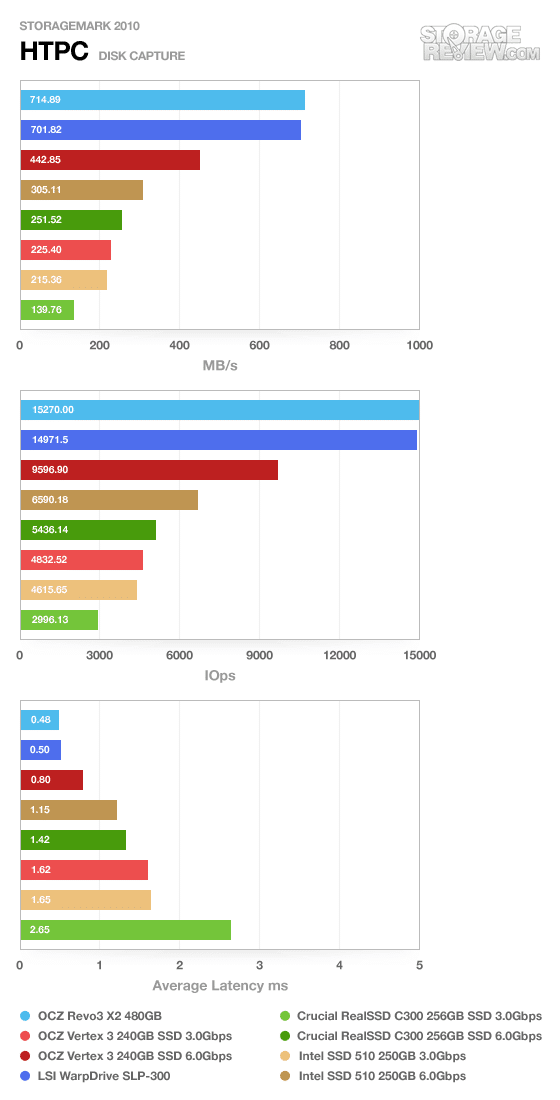
While not exactly a dead heat, the OCZ Revo3 X2 did out-pace the LSI WarpDrive by roughly 13MB/s in average transfer speeds. While not exactly twice as fast as the Vertex 3, it still showed the strongest performance out of the group.
Our second real-life test covers disk activity in a productivity scenario. For all intents and purposes this test shows drive performance under normal daily activity for most users. This test includes: a three hour period operating in an office productivity environment with 32-bit Vista running Outlook 2007 connected to an Exchange server, web browsing using Chrome and IE8, editing files within Office 2007, viewing PDFs in Adobe Reader, and an hour of local music playback with two hours of additional online music via Pandora. In this trace we recorded 4,830MB being written to the drive and 2,758MB being read.
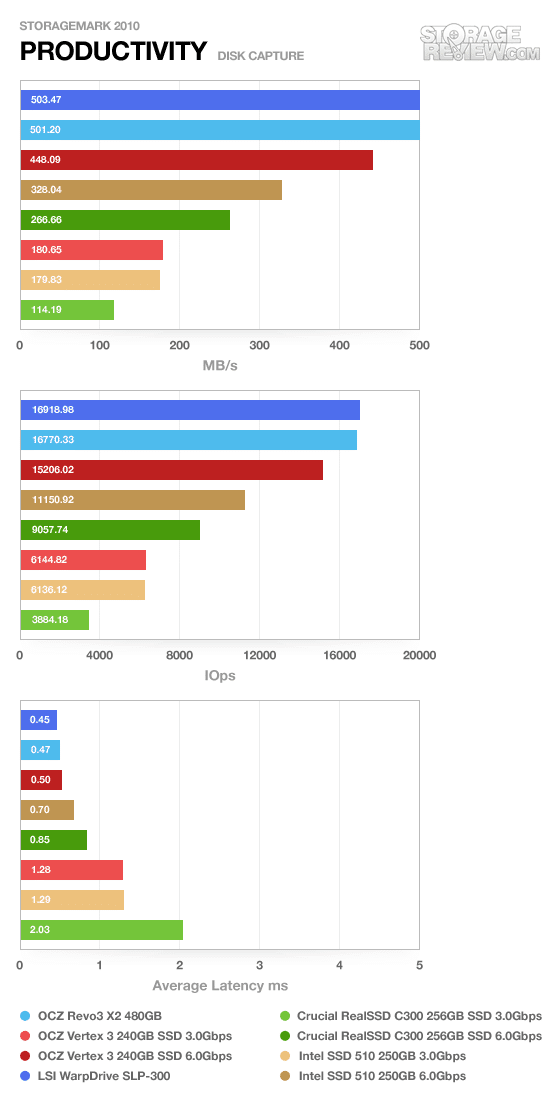
The gap between the LSI WarpDrive and OCZ Revo3 evaporated from the previous trace, with the LSI taking a very small lead of slightly more than 2MB/s.
Our third real-life test covers disk activity in a gaming environment. Unlike the HTPC or Productivity trace, this one relies heavily on the read performance of a drive. To give a simple breakdown of read/write percentages, the HTPC test is 64% write, 36% read, the Productivity test is 59% write and 41% read, while the gaming trace is 6% write and 94% read. The test consists of a Windows 7 Ultimate 64-bit system pre-configured with Steam, with Grand Theft Auto 4, Left 4 Dead 2, and Mass Effect 2 already downloaded and installed. The trace captures the heavy read activity of each game loading from the start, as well as textures as the game progresses. In this trace we recorded 426MB being written to the drive and 7,235MB being read.
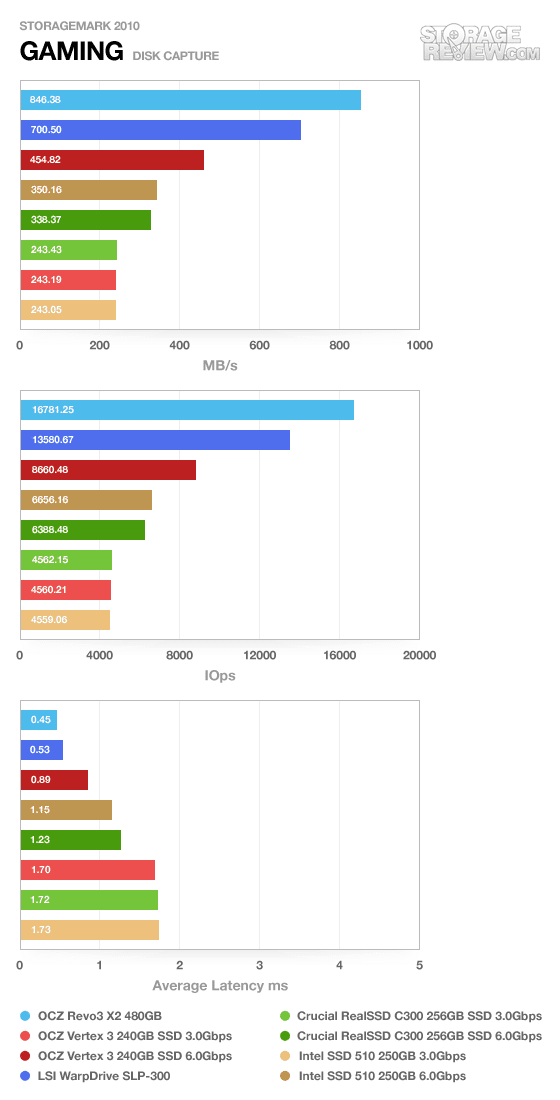
In the final real-world trace the OCZ Revo3 took a huge lead over the WarpDrive, surpassing it with a gap of just under 150MB/s. Compared to the single Vertex 3, it was roughly twice as fast, with transfer speeds measuring 846MB/s.
Power Consumption
Given the unique design of the OCZ RevoDrive3 — drawing power from the PCI-Express slot directly — were unable to perform our standard assortment of power measurements. OCZ has not yet published official power consumption figures of this particular model just yet, although when the specifications are listed we will update this section.
Warranty
OCZ provides an industry-standard three year warranty on the 480GB RevoDrive 3 X2, which is the same length offered on their SATA SSDs. Currently this is matched by all competitors, although two manufacturers have recently upgraded to 5-year warranties on select 25nm-eqiupped SATA drives.
Conclusion
If you are in the market for an impossibly fast SSD, the OCZ RevoDrive 3 X2 is hard to beat. Going head to head with the LSI WarpDrive–priced almost six times more — the Revo3 had no trouble keeping up in scenarios focused on single-user environments. The Revo3 is aimed squarely at enthusiasts and gamers, offering an elegant high-performance storage solution without dealing with the hassle or complexity of setting up a four-drive RAID. Buyers simply plug the drive in and go, no setup required, with it fully bootable from the get-go (with drivers installed).
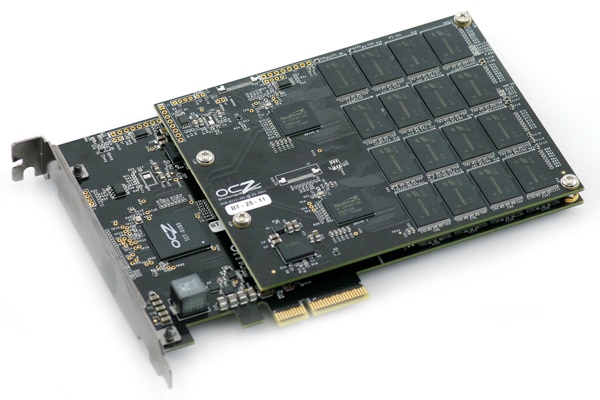
Showing very strong performance off the line, the Revo3 consistently ranked at the top of our charts, matching or beating the WarpDrive. Now, given the right setting, such as heavy multi-threaded loads; the WarpDrive equipped with SLC NAND and six individual SSD controllers had no trouble easily beating the Revo3. This much we expected going in, although we didn’t fully expect to see such staggering differences in single-user benchmarks like the sequential 2MB IOMeter test or the Gaming real-world benchmark. In these two areas the RevoDrive 3 X2 completely blew the WarpDrive away – no contest. It really comes down to what profile each card is designed to fit, with the WarpDrive targeting enterprise users and the Revo3 X2 at gamers and power users.
When it comes down to price, technically speaking, you could get four 120GB OCZ Agility 3 SSDs and a good external RAID card for under what the RevoDrive 3 X2 costs. Going that route though, you would lose out on the simplicity of the single PCIe plug-and-play configuration as well as needing the added bulk of a RAID controller and four SSDs in your desktop. Overall the RevoDrive 3 X2 fits inside a unique market where price falls second in line to performance and elegance of solution. In that segment, it’s almost impossible to beat the performance that this PCIe SSD offers.
Pros
- Super fast
- Plug and play performance, install drivers and go
- Routes data and power through the PCI-Express slot
Cons
- Slightly more expensive than four SSDs and a RAID controller
Bottom Line
If you need the highest levels of performance, but don’t want to deal with the setup or bulk of a four-drive RAID, the OCZ RevoDrive 3 X2 offers performance that rivals even much more expensive enterprise-class solutions.
Editor’s Note: The following review is of pre-production hardware. StorageReview has updated the OCZ RevoDrive 3 X2 review with revised benchmarks with the final build hardware and firmware here.




 Amazon
Amazon